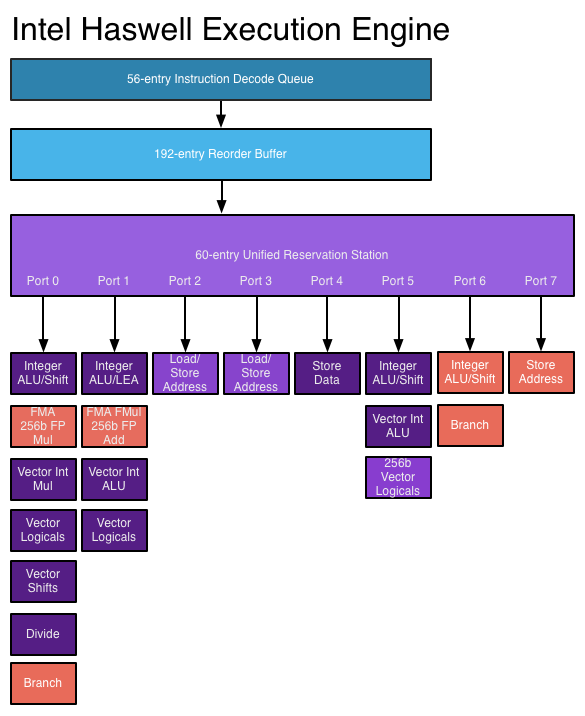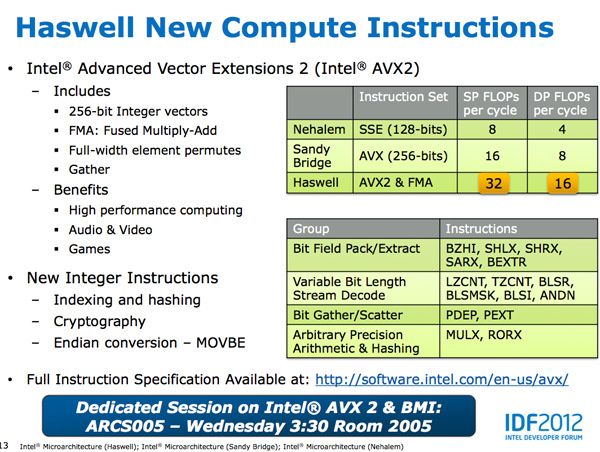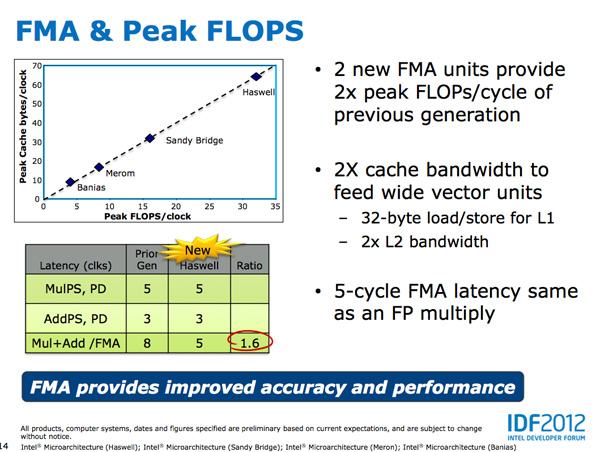Intel's Haswell Architecture Analyzed: Building a New PC and a New Intel
by Anand Lal Shimpi on October 5, 2012 2:45 AM ESTHaswell's Wide Execution Engine
Conroe introduced the six execution ports that we've seen used all the way up to Ivy Bridge. Sandy Bridge saw significant changes to the execution engine to enable 256-bit AVX operations but without increasing the back end width. Haswell does a lot here.
Just as before, I put together a few diagrams that highlight the major differences throughout the past three generations for the execution engine.

The reorder buffer is one giant tracking structure for all of the micro-ops that are in various stages of execution. The size of this buffer is directly impacted by the accuracy of the branch predictor as that will determine how many instructions can be kept in flight at a given time.
The reservation station holds micro-ops as they wait for the data they need to begin execution. Both of these structures grow by low double-digit percentages in Haswell.
Simply being able to pick from more instructions to execute in parallel is one thing, we haven't seen an increase in the number of parallel execution ports since Conroe. Haswell changes that.
From Conroe to Ivy Bridge, Intel's Core micro-architecture has supported the execution of up to six micro-ops in parallel. While there are more than six execution units in the system, there are only six ports to stacks of execution units. Three ports are used for memory operations (loads/stores) while three are on math duty. Over the years Intel has added additional types and widths of execution units (e.g. Sandy Bridge added 256-bit AVX operations) but it hasn't strayed from the 6 port architecture.
Haswell finally adds two more execution ports, one for integer math and branches (port 6) and one for store address calculation (port 7). Including both additional compute and memory hardware is a balanced decision on Intel's part.
The extra ALU and port does one of two things: either improve performance for integer heavy code, or allow integer work to continue while FP math occupies ports 0 and 1. Remember that Haswell, like its predecessors, is an SMT design meaning each core will see instructions from up to two threads at the same time. Although a single app is unlikely to mix heavy vector FP and integer code, it's quite possible that two applications running at the same time may produce such varied instructions. Having more integer ALUs is never a bad thing.
Also using port 6 is another unit that can handle x86 branch instructions. Branch heavy code can now enjoy two independent branch units, or if port 0 is occupied with other math the machine can still execute branches on port 6. Haswell moved the original Core branch unit from port 5 over to port 0, the most capable port in the system, so a branch unit on a lightly populated port makes helps ensure there's no performance regression as a result of the change.
Sandy Bridge made ports 2 & 3 equal class citizens, with both capable of being used for load or store address calculation. In the past you could only do loads on port 2 and store addresses on port 3. Sandy Bridge's flexibility did a lot for load heavy code, which is quite common. Haswell's dedicated store address port should help in mixed workloads with lots of loads and stores.
The other major addition to the execution engine is support for Intel's AVX2 instructions, including FMA (Fused Multiply-Add). Ports 0 & 1 now include newly designed 256-bit FMA units. As each FMA operation is effectively two floating point operations, these two units double the peak floating point throughput of Haswell compared to Sandy/Ivy Bridge. A side effect of the FMA units is that you now get two ports worth of FP multiply units, which can be a big boon to legacy FP code.
Fused Multiply-Add operations are incredibly handy in all sorts of media processing and 3D work. Rather than having to independently multiply and add values, being able to execute both in tandem via a single execution port increases the effective execution width of the machine. Note that a single FMA operation takes 5 cycles in Haswell, which is the same latency as a FP multiply from Sandy/Ivy Bridge. In the previous generation a floating point multiply+add took 8 cycles, so there's a good latency improvement here as well as the throughput boost from having two FMA units.

Intel focused a lot on adding more execution horsepower in Haswell without creating a power burden for legacy use cases. All of the new units can be shut off when not in use. Furthermore, Intel went in and ensured that this applied to the older execution units as well: in Haswell if you're not doing work, you're not consuming power.












245 Comments
View All Comments
Peanutsrevenge - Friday, October 5, 2012 - link
What the hell are you guys bitching about?Of course the iPhone articles are going to be longer and more numerous than GS3 articles.
iPhone releases come with new iOS releases and have their own eco-system.
Android phone releases use a common OS across them and therefore much of what's in one article doesn't need repeating in another.
Anand liking Apple is not our problem, I can see why people like them (not so much Anand) and that's fine, personally I dislike them (hate was originally typed, but was edited due to being incorrect), but still respect them and respect people who purchase their products (and pay for their litigation).
An entire page of comments talking about how Anand isn't allowed to like or talk about Apple products because you guys don't like is ridiculous, they're a PC company and should exist on a PC website.
Grow up.
Kepe - Friday, October 5, 2012 - link
Sure, but I'm talking about dedicating entire, long articles to such things as the iPhone display or why it doesn't have a certain feature and so on. The SGS III has a very interesting display, too. Still it didn't get nearly as much attention. Of course Anand is allowed to talk about Apple products. What I want, though, is Anand(tech) to be as thorough in reviewing other products, too, or then stop making those huge articles only about Apple products. Because that is biased.In the Macbook Pro Retina article Anand talked about the cooling system and the fan blades for one page. When I read any other laptop review on Anandtech, cooling is briefly described in a sentence or two.
Dedicating so much attention to just one company's products makes it look like Anandtech is biased. And that is not good.
Magik_Breezy - Sunday, October 14, 2012 - link
Hopefully because of these comments they'll finally see what we want, not some Apple crap. Good engineering stupid managementSpunjji - Thursday, October 18, 2012 - link
Nailed it.vFunct - Saturday, October 6, 2012 - link
Android products would get more coverage if they bothered to do any engineering on them. Since they don't push the technology the way Apple does, they don't need a more in-depth review.StevoLincolnite - Saturday, October 6, 2012 - link
You're kidding right? Hardware wise Apple has always been behind the curve compared to the competition in every facet of it's product line-ups or very quickly beaten.lmcd - Saturday, October 6, 2012 - link
Umm, I would disagree there. Apple has always been ahead of the curve in GPUs and this is the FIRST TIME SINCE BEFORE THE A-SERIES that Apple has had a GPU without an overwhelming lead on the competition for more than half a year.*While GPU selection isn't always huge, it's one of the biggest points of differentiation in mobile chips, along with power use.
*excluding the A4 if you count from when it was first in a phone as opposed to in a tablet.
Magik_Breezy - Sunday, October 14, 2012 - link
The last time I played a game on my phone was about 8 months ago and I'm 15! To say that Apple pushes their hardware is naive as it gets.The Galaxy S III was the best purchase Ive made, even my mum doesn't like my iPhone 4.
vFunct - Sunday, October 7, 2012 - link
Yes, Apple products are always ahead of compromised Android products.Android devices are badly engineered, like incorporating LTE when the battery can't handle it, for example. Apple doesn't compromise on their design.
Kepe - Monday, October 8, 2012 - link
How much does Apple pay you for a comment praising them?